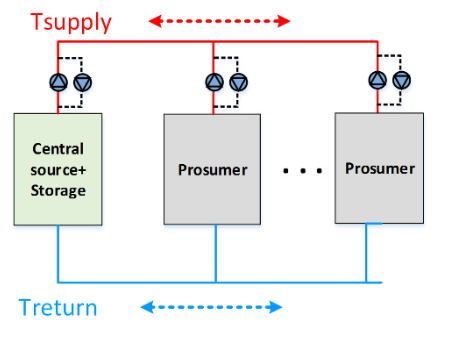CSSC LAB - Exploring the CSSC Demo Sites: MAKING A SCHOOL A HEAT PROSUMER THROUGH THERMAL ENERGY PRODUCTION IN CROATIA
09-12-2020
Scheduled to be launched in July 2021, the Croatian demo site in Zaprešić in Zagreb Country will be the first heat prosumer in Croatia, making it possible for a school to capture thermal energy for its own consumption and to feed additional heat into the District Heating System (DHS). This smart heating solution, achieved through a bidirectional exchange of thermal energy between the DHS and the demo site, has been facilitated through close collaboration between energy companies, cities, counties, energy agencies and international manufacturers of equipment. All of these actors working together have made it possible to develop an innovative solution to meeting the school’s energy needs while switching to renewable energy sources.
How does the system work? Heat is captured in the school using solar thermal collectors and then used to heat the building as required. Additional heat is stored in the heat storage for later use and once this is full, is fed into the District Heating System (DHS), making it available to other users. Conversely, during low production periods, the school receives thermal energy from the DHS once its own reserves have been exhausted. This allows to compensate for any shortages during times of bad weather or peak usage.
What are the benefits of such a system? First of all, the school will manage to lower its reliance on fossil fuels for heating, switching from gas to thermal energy. It will therefore directly reduce its carbon footprint.

Secondly, by including storage facilities in the system, it can store additional heat, which it can use during low production times. This helps avoid wastage and maximises the amount of green energy it consumes. Thirdly, since it feeds excess heat into the DHS and uses it as a heat storage for other users, it contributes to making the entire DHS greener.
For the site to be established, the following equipment will be procured: sensing and monitoring equipment, regulation and control systems, visualisation, demonstration and educational facilities as well as a Smart District Heating Substation. The purpose of the substation is to regulate the bidirectional exchange of heat between the building and DHS. Using developed management and control programmes, the smart substation will regulate valves and other equipment, deciding to either heat the building, store thermal energy in the heat storage or send it to the DHS for other users.
How will the community benefit from this? The thermal energy captured will be used to heat a high school in Zaprešić, which is owned by the regional public authority. As the costs for the Operation and Maintenance of the solar thermal collectors is lower than the natural gas alternatives, local residents will pay lower taxes. Furthermore, this pilot will help raise awareness levels regarding renewable energy among the school’s students, its staff and the approximately 1000 gym users also accessing the building. Communication activities by CSSC Lab on the demo site will further contribute to greater environmental consciousness at local level.
It is also worth noting that this case serves as a good practice example for cooperation between the heating sector and the local municipality. In fact, this case shows that a heat prosumer triangle can be achieved through cooperation between the district heating system owner, owners of public buildings and energy agencies. The demo can therefore also be seen as a pilot for promoting the growth of green heat prosumers in Croatia, which would greatly contribute to decarbonising the Croatian energy landscape in the long-term.
There is large replication potential for the demo site since there are many public buildings in Zagreb Country including health care institutions, which would benefit from applying this solution. In fact, the approach is simple: In cases where buildings are connected to the DHS, they can install solar thermal collectors on their roofs as well as a smart substation for the bidirectional exchange, generating their own green energy and feeding excess energy into the DHS. This would help Croatian cities successfully address existing legislative obligations on increasing their use of green energy and making DHSs cleaner.
